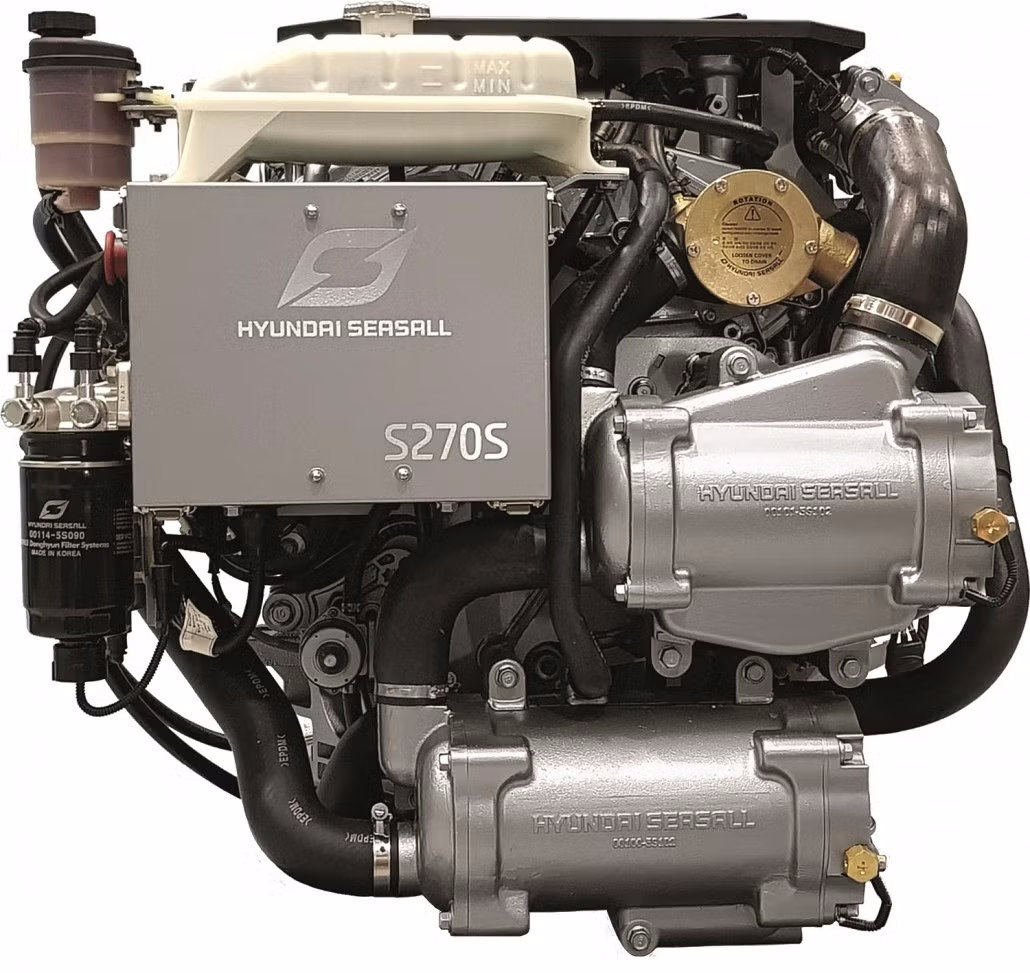December 10, 2025 Harley-Davidson Support
The Engine Gateway update brings improvements to the Suzuki protocol and adds support for the latest-generation Harley-Davidson motorcycles.
Engine Gateway for marine engines with a digital CAN interface supports more than a dozen different protocols, some of which originated in the automotive market. One of the most popular protocols, J1939, is widely used in trucks and heavy equipment. We also support Hyundai and Volkswagen protocols that were brought into marinized engines from the automotive world.
And now we decided to go one step ahead by adding the protocol for Harley-Davidson motorcycles. Who knows - maybe one day we'll order a luxurious black powerboat lavishly decorated with chrome and leather? In that case, simply add the following line to the configuration file:
PROTOCOLS=HARLEY
and everything will work.
We recorded a video for you showing a Raymarine Axiom marine display installed on a motorcycle, displaying RPM, oil temperature, engine hours, fuel level and volume in the tank, speed (by water, because we are expecting a boat from them), battery voltage, engaged gear, and engine warnings.
We also installed an NMEA 2000 Wi-Fi Gateway on this motorcycle so the rider can switch the Raymarine Axiom into a large-chart mode and at the same time view engine data on a mobile phone via Web Gauges. After all, if he installs a display slightly larger than ours, he won't be able to see the stock gauges located on the motorcycle's tank.
In this update, we improved Suzuki engine support by adding engine warnings (the oil-change reminder is shown as "Maintenance need", and the remaining warnings are mapped to NMEA 2000 alerts in a more intuitive way).
We also added conversion of Suzuki SMG4 data for fuel-tank level and total fuel used. To make Engine Gateway display the tank capacity defined in the SMG4 settings, set TANK_CAPACITY_x to DEFAULT in the configuration file.
To connect Engine Gateway to Suzuki engines, we have prepared an adapter cable (see above) priced at USD $39. It can be ordered from our online store together with the Engine Gateway, and will soon be available from our dealers.
Please note that Engine Gateway does not support the K-Line interface. It cannot replace Engine Interface Cables 99C0-88149-xxx, Engine Connect Gateway 99C0-88171, or the SMD Gateway Unit 34923-96L02. It also cannot replace the Suzuki SMG4 if it is configured for the K-Line protocol (SPC 1.0 engines) rather than CAN.
Our product can replace the SMD Gateway 34923-96L13 and the Suzuki SMG4 display (when configured for the CAN protocol). The gateway is compatible with all Suzuki SPC 2.0 engines (2022 and newer).
Firmware update 1.51 for Engine Gateway is available on the Downloads page.
October 23, 2025 Suzuki and Hyundai protocols
We are pleased to announce that Engine Gateway now supports Suzuki outboard motors and Hyundai marine engines.
To install update 1.50, you must first install update 1.49. After installing 1.49, wait for five short green LED signals and one long signal, after which the device will enter normal operating mode and can be updated to version 1.50 as usual.
We have slightly modified the configuration file. Now the protocols are enabled with a single line. For example, instead of:
MEFI4B=ON
Now you need to specify:
PROTOCOLS=MEFI4B
The following line will be written to the YDEGSAVE.TXT configuration file:
PROTOCOLS=J1939,MEFI4B
The MEFI4B protocol is an extension of the J1939 protocol, so when MEFI4B is enabled, it is added automatically.
We have added comments to the YDEGSAVE.TXT file, so now you will need to refer to the manual less often when configuring the device. We are working on an updated manual that will reflect all the changes in the settings file.
Support for three-phase generators has also been added, and modern Raymarine displays will now be able to provide detailed data on all phases, not just summarized data on average power, voltage, and frequency.
Thanks to our users, we have received Hyundai SeasAll S270 engine records, and now you can see RPM, torque, instant fuel consumption, generator voltage, and coolant temperature on your plotters. We are waiting for additional records from users to add engine warnings and errors and engine hour data in the next product update.
Modern Suzuki outboard motors have two CAN buses. One is connected to the electronic throttle control handle (speed 500 kbps), the other to the Suzuki SMG4 display (speed 250 kbps). The buses have different protocols, and we have added support for both.
The internal bus protocol is enabled by setting:
PROTOCOLS=SUZUKI,OPT1
This bus provides access to engine speed, voltage, trim angle, and gear position. We do not recommend connecting to this bus (4-pin connector with 120 Ohm terminators).
The instrument bus provides access to RPM, instantaneous fuel consumption, coolant temperature, voltage, engine hours, tilt/trim angle, and gear position. We are continuing to research this protocol and plan to add engine warnings and errors.
The connection is made to the tachometer connector (8 pins), and we plan to offer adapters for connection in the near future.
Installing the Engine Gateway eliminates the need to install the SMG4 device and saves space on the boat's dashboard.
We would be happy to add even more protocols to our remarkable device. If you have an unusual engine with a CAN interface, please contact us. Engine Gateway allows you to record data from the engine network on a memory card, which can be used to study its protocol. Engine Gateway can send messages from the engine network to the NMEA 2000 network and vice versa, but unless this is directly enabled by the user, it only reads data from the engine network, which virtually eliminates the possibility of our device affecting the engine's performance.
Firmware update for Engine Gateway is available on the Downloads page.
September 11, 2025 Latching buttons support
Latching buttons are now supported in both Switch Control and Circuit Control.
Circuit Control and Switch Control are designed for digital control of loads. This means that loads connected to Circuit Control can be turned on or off from the buttons wired to it, from navigation displays, from mobile phones (via our Wi Fi Gateway), and from auxiliary control stations with physical buttons where Switch Control is installed.
In this scenario, latching buttons do not reflect the state of the load: a user can turn a load on with the button, then turn it off on the chartplotter, and the button will remain in the pressed position. The only element that reflects the load state is the indicator light in the button.
Nevertheless, there is a use case where latching buttons are preferable to momentary buttons. On the Lowrance HDS PRO display shown in the screenshot, using digital switching for loads is not very convenient and requires several taps to switch away from the chart or sonar page. Therefore, the user will prefer to use a physical button installed next to the display.
A reasonable question may arise: why install Circuit Control on this boat at all? The answer is simple: the boat's panel space is limited, and it was decided to use miniature but low power buttons. In this case, high power loads such as bilge pumps should be switched via relays. This is where Circuit Control has an advantage, because it uses latching (bistable) relays and does not consume energy to hold the contacts.
The second reason is the insufficient number of buttons that fit on the panel. Some auxiliary loads - for example, turning on the audio speaker lighting - do not have a physical button and are switched only from the Lowrance display.
Thus, in this installation latching buttons turned out to be genuinely more convenient, because in most cases they reflect the load state.
Moreover, they have another property that can be useful. When power is applied, Circuit Control restores the loads to the state they were in before power was removed. However, in latching button mode, the device switches loads according to the current positions of the buttons connected to it.
You can check the current mode and select a new one with the command:
YD:BUTTONS [ MOMENTARY | LATCH ]
On the boat described in this article, Circuit Control also controls power to the navigation instruments and to the NMEA 2000 network; for this it is connected to the NMEA 2000 network through a power isolator.
Firmware update for Circuit Control and Switch Control are available on the Downloads page.
Next articles:
- Ethernet Gateway for Lowrance / September 9, 2025
- 10-year anniversary / May 12, 2025
- Raymarine, your turn! / February 17, 2025



